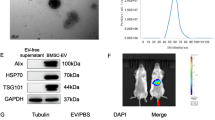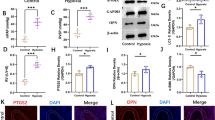Abstract
Background
Based on pre-existing evidence, KCNQ1OT1 has been pointed out to be closely related to myocardial and cerebral ischemia reperfusion injury diseases. Herein, the objective of our study is to probe into the potential function as well as the underlying mechanism of KCNQ1OT1 on hepatic ischemia reperfusion injury (HIRI).
Methods
Using C57BL/6 J mice and primary mouse hepatocytes were conducted to establish HIRI model in vivo and in vitro. Cell viability was examined using CCK-8 assay and EdU assay. Flow cytometric analysis was performed to evaluate the pyroptosis. Dual-luciferase reporter assay was employed to verify the interaction relationships. qRT-PCR and Western blot were adopted to analyze the mRNA and protein level. Histopathological alteration of liver tissue was evaluated by HE staining. Immunohistochemistry (IHC) was performed to measure NLRP3 and caspase 1.
Results
Our data revealed that KCNQ1OT1 expression was ascending in hepatic tissue of HIRI mouse. Moreover, deprivation of KCNQ1OT1 mitigated I/R-induced hepatic injury and pyroptosis in vivo. Further experiments demonstrated that silencing KCNQ1OT1 promoted proliferation and inhibited pyroptosis in hypoxia/reoxygenation (H/R)-induced primary mouse hepatocytes. Mechanistically, KCNQ1OT1 functioned as a competing endogenous RNA which sponged miR-142a-3p, therefore promoted HMGB1 expression to activate TLR4/NF-κB signaling pathway in HIRI.
Conclusion
LncRNA KCNQ1OT1 elevated HMGB1 expression through binding to miR-142a-3p, thereby promoting pyroptosis in HIRI.






Similar content being viewed by others
Availability of data and material
The datasets used or analyzed during the current study are available from the corresponding author on reasonable request.
Code availability
Not applicable.
6. References
Chen X, Zhang J, Xia L, Wang L, Li H, Liu H, Zhou J, Feng Z, Jin H, Yang J, Yang Y, Wu B, Zhang L, Chen G, Wang G (2020) beta-Arrestin-2 attenuates hepatic ischemia-reperfusion injury by activating PI3K/Akt signaling. Aging (Albany NY) 13:2251–2263. https://doi.org/10.18632/aging.202246
Linkermann A, Bräsen J, Darding M, Jin M, Sanz A, Heller J, De Zen F, Weinlich R, Ortiz A, Walczak H, Weinberg J, Green D, Kunzendorf U, Krautwald S (2013) Two independent pathways of regulated necrosis mediate ischemia-reperfusion injury. Proc Natl Acad Sci USA 110:12024–12029. https://doi.org/10.1073/pnas.1305538110
Deng J (2021) Advanced research on the regulated necrosis mechanism in myocardial ischemia-reperfusion injury. Int J Cardiol 334:97–101. https://doi.org/10.1016/j.ijcard.2021.04.042
Zheng ZQ, Li ZX, Zhou GQ, Lin L, Zhang LL, Lv JW, Huang XD, Liu RQ, Chen F, He XJ, Kou J, Zhang J, Wen X, Li YQ, Ma J, Liu N, Sun Y (2019) Long noncoding RNA FAM225A promotes nasopharyngeal carcinoma tumorigenesis and metastasis by acting as ceRNA to sponge miR-590-3p/miR-1275 and upregulate ITGB3. Cancer Res 79:4612–4626. https://doi.org/10.1158/0008-5472.CAN-19-0799
Zhang H, Liu Y, Li M, Peng G, Zhu T, Sun X (2021) The Long Non-coding RNA SNHG12 functions as a competing endogenous rna to modulate the progression of cerebral ischemia/reperfusion injury. Mol Neurobiol. https://doi.org/10.1007/s12035-021-02648-8
Li Z, Li Y, He Z, Li Z, Xu W, Xiang H (2021) The preventive effect of cardiac sympathetic denervation induced by 6-OHDA on myocardial ischemia-reperfusion injury: THE CHANGES of lncRNA/circRNAs-miRNA-mRNA network of the upper thoracic spinal cord in rats. Oxid Med Cell Longev 2021:2492286. https://doi.org/10.1155/2021/2492286
Dai B, Qiao L, Zhang M, Cheng L, Zhang L, Geng L, Shi C, Zhang M, Sui C, Shen W, Sun Y, Chen Q, Hui D, Wang Y, Yang J (2019) lncRNA AK054386 functions as a ceRNA to sequester miR-199 and induce sustained endoplasmic reticulum stress in hepatic reperfusion injury. Oxid Med Cell Longev 2019:8189079. https://doi.org/10.1155/2019/8189079
Huang X, Gao Y, Qin J, Lu S (2018) The mechanism of long non-coding RNA MEG3 for hepatic ischemia-reperfusion: mediated by miR-34a/Nrf2 signaling pathway. J Cell Biochem 119:1163–1172. https://doi.org/10.1002/jcb.26286
Rong J, Pan H, He J, Zhang Y, Hu Y, Wang C, Fu Q, Fan W, Zou Q, Zhang L, Tang Y, Peng X, Wang P, Xiang Y, Peng J, Liu Z, Zheng Z (2020) Long non-coding RNA KCNQ1OT1/microRNA-204-5p/LGALS3 axis regulates myocardial ischemia/reperfusion injury in mice. Cell Signal 66:109441. https://doi.org/10.1016/j.cellsig.2019.109441
Ren Y, Gao XP, Liang H, Zhang H, Hu CY (2020) LncRNA KCNQ1OT1 contributes to oxygen-glucose-deprivation/reoxygenation-induced injury via sponging miR-9 in cultured neurons to regulate MMP8. Exp Mol Pathol 112:104356. https://doi.org/10.1016/j.yexmp.2019.104356
Kadono K, Kageyama S, Nakamura K, Hirao H, Ito T, Kojima H, Dery KJ, Li X, Kupiec-Weglinski JW (2021) Myeloid ikaros-SIRT1 signaling axis regulates hepatic inflammation and pyroptosis in ischemia-stressed mouse and human liver. J Hepatol. https://doi.org/10.1016/j.jhep.2021.11.026
Liu H, Zhao Z, Wu T, Zhang Q, Lu F, Gu J, Jiang T, Xue J (2021) Inhibition of autophagy-dependent pyroptosis attenuates cerebral ischaemia/reperfusion injury. J Cell Mol Med 25:5060–5069. https://doi.org/10.1111/jcmm.16483
Guo X, Hu S, Liu JJ, Huang L, Zhong P, Fan ZX, Ye P, Chen MH (2021) Piperine protects against pyroptosis in myocardial ischaemia/reperfusion injury by regulating the miR-383/RP105/AKT signalling pathway. J Cell Mol Med 25:244–258. https://doi.org/10.1111/jcmm.15953
Nie C, Ding X, A R, Zheng M, Li Z, Pan S and Yang W, (2021) Hydrogen gas inhalation alleviates myocardial ischemia-reperfusion injury by the inhibition of oxidative stress and NLRP3-mediated pyroptosis in rats. Life Sci 272:119248. https://doi.org/10.1016/j.lfs.2021.119248
Wu Y, Qiu G, Zhang H, Zhu L, Cheng G, Wang Y, Li Y, Wu W (2021) Dexmedetomidine alleviates hepatic ischaemia-reperfusion injury via the PI3K/AKT/Nrf2-NLRP3 pathway. J Cell Mol Med 25:9983–9994. https://doi.org/10.1111/jcmm.16871
Pan W, Wang L, Zhang XF, Zhang H, Zhang J, Wang G, Xu P, Zhang Y, Hu P, Zhang XD, Du RL, Wang H (2019) Hypoxia-induced microRNA-191 contributes to hepatic ischemia/reperfusion injury through the ZONAB/Cyclin D1 axis. Cell Death Differ 26:291–305. https://doi.org/10.1038/s41418-018-0120-9
Liu L, Yang B, Wang L, Huang J, Chen W, Ban Q, Zhang Y, You R (2020) Yin L and Guan YJJomcB. Biomimetic bone tissue engineering hydrogel scaffolds constructed using ordered CNTs and HA induce the proliferation and differentiation of BMSCs 8:558–567. https://doi.org/10.1039/c9tb01804b
Pan WM, Wang H, Zhang XF, Xu P, Wang GL, Li YJ, Huang KP, Zhang YW, Zhao H, Du RL, Huang H, Zhang XD, Zhang JX (2020) miR-210 participates in hepatic ischemia reperfusion injury by forming a negative feedback loop with SMAD4. Hepatology 72:2134–2148. https://doi.org/10.1002/hep.31221
Guo B, Cheng Y, Yao L, Zhang J, Lu J, Qi H, Chen H (2021) LncRNA HOTAIR regulates the lipid accumulation in non-alcoholic fatty liver disease via miR-130b-3p/ROCK1 axis. Cell Signal 90:110190. https://doi.org/10.1016/j.cellsig.2021.110190
Liu Y, Wen C, Zhang Y, Liu Z, He Q, Cui M, Peng H, Wang Y, Zhang X, Li X, Wang Q (2021) Aberrant expression of SNHG12 contributes to N, N-dimethylformamide-induced hepatic apoptosis both in short-term and long-term DMF exposure. Toxicol Res (Camb) 10:1022–1033. https://doi.org/10.1093/toxres/tfab088
Qin R, Huang W, Huang Y, Zhang Z, Su Y, Chen S, Wang H (2022) lncRNA MEG3 modulates hepatic stellate cell activation by sponging miR145 to regulate PPARgamma. Mol Med Rep. https://doi.org/10.3892/mmr.2021.12519
Tang B, Bao N, He G, Wang J (2019) Long noncoding RNA HOTAIR regulates autophagy via the miR-20b-5p/ATG7 axis in hepatic ischemia/reperfusion injury. Gene 686:56–62. https://doi.org/10.1016/j.gene.2018.10.059
Ying D, Zhou X, Ruan Y, Wang L, Wu X (2020) LncRNA Gm4419 induces cell apoptosis in hepatic ischemia-reperfusion injury via regulating the miR-455-SOX6 axis. Biochem Cell Biol 98:474–483. https://doi.org/10.1139/bcb-2019-0331
Wang L, Qu P, Yin W, Sun J (2021) Lnc-NEAT1 induces cell apoptosis and inflammation but inhibits proliferation in a cellular model of hepatic ischemia/reperfusion injury. J Int Med Res 49:300060519887251. https://doi.org/10.1177/0300060519887251
Ming N, Na HST, He JL, Meng QT, Xia ZY (2019) Propofol alleviates oxidative stress via upregulating lncRNA-TUG1/Brg1 pathway in hypoxia/reoxygenation hepatic cells. J Biochem 166:415–421. https://doi.org/10.1093/jb/mvz054
Li Y, Yi M, Wang D, Zhang Q, Yang L, Yang C (2020) LncRNA KCNQ1OT1 regulates endoplasmic reticulum stress to affect cerebral ischemia-reperfusion injury through targeting miR-30b/GRP78. Inflammation 43:2264–2275. https://doi.org/10.1007/s10753-020-01295-w
Li X, Dai Y, Yan S, Shi Y, Han B, Li J, Cha L, Mu J (2017) Down-regulation of lncRNA KCNQ1OT1 protects against myocardial ischemia/reperfusion injury following acute myocardial infarction. Biochem Biophys Res Commun 491:1026–1033. https://doi.org/10.1016/j.bbrc.2017.08.005
Yang F, Qin Y, Wang Y, Li A, Lv J, Sun X, Che H, Han T, Meng S, Bai Y, Wang L (2018) LncRNA KCNQ1OT1 mediates pyroptosis in diabetic cardiomyopathy. Cell Physiol Biochem 50:1230–1244. https://doi.org/10.1159/000494576
Zhang Y, Song Z, Li X, Xu S, Zhou S, Jin X, Zhang H (2020) Long noncoding RNA KCNQ1OT1 induces pyroptosis in diabetic corneal endothelial keratopathy. Am J Physiol Cell Physiol 318:C346–C359. https://doi.org/10.1152/ajpcell.00053.2019
Yang F, Qin Y, Lv J, Wang Y, Che H, Chen X, Jiang Y, Li A, Sun X, Yue E, Ren L, Li Y, Bai Y, Wang L (2018) Silencing long non-coding RNA Kcnq1ot1 alleviates pyroptosis and fibrosis in diabetic cardiomyopathy. Cell Death Dis 9:1000. https://doi.org/10.1038/s41419-018-1029-4
Niu B, Yao L, Zhang Y, Xia X, Su H (2021) LncRNA KCNQ1OT1 promoted hepatitis C virus-induced pyroptosis of β-cell through mediating the miR-223-3p/NLRP3 axis. Ann Transl Med 9:1387. https://doi.org/10.21037/atm-21-3862
Liu T, Wu D, Zhang F, Zhang T, He M, Zhao Y, Li J, Li L, Xu Y (2021) miR-142a-3p enhances FlaA N/C protection against radiation-mediated intestinal injury by modulating IRAK1/NF-κB signaling pathway. Int J Radiat Oncol Biol Phys. https://doi.org/10.1016/j.ijrobp.2021.12.003
Mi L, Zhang Y, Xu Y, Zheng X, Zhang X, Wang Z, Xue M, Jin X (2019) HMGB1/RAGE pro-inflammatory axis promotes vascular endothelial cell apoptosis in limb ischemia/reperfusion injury. Biomed Pharmacother 116:109005. https://doi.org/10.1016/j.biopha.2019.109005
Deng M, Tang Y, Li W, Wang X, Zhang R, Zhang X, Zhao X, Liu J, Tang C, Liu Z, Huang Y, Peng H, Xiao L, Tang D, Scott M, Wang Q, Liu J, Xiao X, Watkins S, Li J, Yang H, Wang H, Chen F, Tracey K, Billiar T, Lu B (2018) The endotoxin delivery protein HMGB1 mediates caspase-11-dependent lethality in sepsis. Immunity 49:740-753.e7. https://doi.org/10.1016/j.immuni.2018.08.016
Hua S, Ma M, Fei X, Zhang Y, Gong F, Fang M (2019) Glycyrrhizin attenuates hepatic ischemia-reperfusion injury by suppressing HMGB1-dependent GSDMD-mediated kupffer cells pyroptosis. Int Immunopharmacol 68:145–155. https://doi.org/10.1016/j.intimp.2019.01.002
Xu L, Ge F, Hu Y, Yu Y, Guo K, Miao C, Fip J (2021) Sevoflurane postconditioning attenuates hepatic ischemia-reperfusion injury by limiting HMGB1/TLR4/NF-κB pathway via modulating microrna-142 in vivo and in vitro. Front Pharmacol 12:646307. https://doi.org/10.3389/fphar.2021.646307
Gendy A, Elnagar M, Allam M, Mousa M, Khodir A, El-Haddad A, Elnahas O, Fayez S, El-Mancy SJB, Biomedecine p and pharmacotherapie, (2022) Berberine-loaded nanostructured lipid carriers mitigate warm hepatic ischemia/reperfusion-induced lesion through modulation of HMGB1/TLR4/NF-κB signaling and autophagy. Biomed Pharmacother 145:112122. https://doi.org/10.1016/j.biopha.2021.112122
Acknowledgements
Not applicable.
Funding
This study was supported by Hunan Cancer Hospital Climb Plan (Grant No. 2020NSFC-A002), Hunan Provincial Natural Science Foundation of China (Grant No. 2019JJ80020), and Hunan Provincial Natural Science Foundation of China (Grant No. 806268174046).
Author information
Authors and Affiliations
Contributions
CL contributed to conceptualization, methodology, and writing- Original draft preparation; YP contributed to data curation; HS and LW contributed to visualization and investigation; LJ contributed to validation; and SZ contributed to supervision, writing- reviewing, and editing.
Corresponding author
Ethics declarations
Conflicts of interest
The authors declare that they have no conflict of interest.
Ethics approval and consent to participate
All animal experiments and related procedures were approved by the Ethics Committee of Hunan Cancer Hospital (approval No. 2021–074).
Consent for publication
Not applicable.
Additional information
Publisher's Note
Springer Nature remains neutral with regard to jurisdictional claims in published maps and institutional affiliations.
Rights and permissions
Springer Nature or its licensor (e.g. a society or other partner) holds exclusive rights to this article under a publishing agreement with the author(s) or other rightsholder(s); author self-archiving of the accepted manuscript version of this article is solely governed by the terms of such publishing agreement and applicable law.
About this article
Cite this article
Liang, C., Peng, Y., Sun, H. et al. Silencing lncRNA KCNQ1OT1 reduced hepatic ischemia reperfusion injury-induced pyroptosis by regulating miR-142a-3p/HMGB1 axis. Mol Cell Biochem 478, 1293–1305 (2023). https://doi.org/10.1007/s11010-022-04586-y
Received:
Accepted:
Published:
Issue Date:
DOI: https://doi.org/10.1007/s11010-022-04586-y




